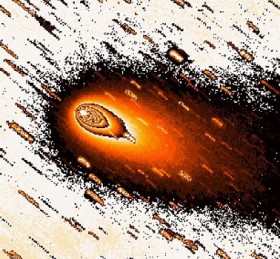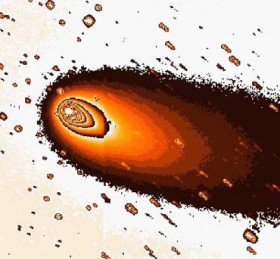Press Release 08/2006 - 5th May 2006
Odyssey in Space
Max Planck researchers observe a comet splitting into a set of mini-comets
Researchers from the Max Planck Institute for Solar System Research (MPS) enter into various observational programs of the Comet 73P/Schwassmann-Wachmann 3 (SW 3). During May and June 2006 this comet is of great scientific interest: it is splitting into several distinct pieces, its main fragment comes nearest to the Earth (11.6 Mill. km) around May 12, and this distance is the closest a comet ever approached Earth in more than twenty years.
MPS researchers and close collaborators have been recently and will continue observing the comet and its main fragments in great detail during May from Chile (La Silla and Paranal), Bulgaria (Rozhen), Spain (Calar Alto), USA (Mt. Graham, Arizona), and Germany (Tautenburg), among other possible observational facilities. These observations will obtain valuable information, specially as to study sublimation of volatiles from dust grains, grain dissolution/fragmentation with distance from nucleus, to determine gas and dust production of SW3 fragments, to search for small fragments around larger ones, to study dust properties (colours, phase angle), to determine rotational period and break-up limit of fragment C (the brightest one), between other studies. The recent nucleus splitting of SW 3 fragments (for instance B and C) is an unexpected event, but is a very valuable add-on of the planned science program since it will allow us to study the rare event of comet break-up in great detail. Questions like: What caused the splitting of the comet? Will the splitting process continue? Will the comet finally disintegrate? will be tackled.
SW 3 was initially discovered by Arnold Schwassmann and Arno Arthur Wachmann on May 2, 1930. It moves in an elliptical orbit with an orbital period of 5.4 years, and belongs to the so-called "Jupiter family" of comets. In 1995, unexpectedly, SW 3 began to disintegrate; it was seen in observations performed at the European Southern Observatory (ESO) by Hermann Böhnhardt (MPS) and Hans-Ulrich Käufl (ESO) to break into three large pieces labeled A, B, C. Later, in 1996, two more fragments, D & E, were discovered. In 2001 only the fragments C, B, and E were re-detected. In the course of 2006 at least 70 fragments have been detected. SW3 was the very first target comet of ESA's ROSETTA mission before 46P/Wirtanen and successively 67P/Churyumov-Gerasimenko got selected and it was also target for NASA's CONTOUR mission before it exploded in space.

|

|
Figure 1 and 2: Images of the fragment C (left) and B (right) taken with the 2-m Schmidt telescope in at the Thüringer Landessternwarte Tautenburg (Germany). The fragments were observed in April 2006 for a total of a few minutes with the red filter a few days before fragment B started to split off.
(Image: MPS)
|
Further informations
 Comet 73PSW3 at MPS
Comet 73PSW3 at MPS
Dr. Miriam Rengel
Max-Planck-Institut für Sonnensystemforschung
Max-Planck-Str. 2
37191 Katlenburg-Lindau
Tel.: 05556-979-529
E-Mail:  rengel@mps.mpg.de
rengel@mps.mpg.de
